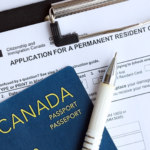
Learning French: A Key Step Toward Canadian Immigration Success
French proficiency has become one of the most powerful assets for individuals seeking permanent residency (PR) in Canada. With new immigration targets and category-based draws emphasizing bilingualism, learning French can significantly improve your chances of selection under Express Entry and several Provincial Nominee Programs (PNPs).
Why French Matters in Canadian Immigration
Being fluent in both of Canada’s official languages—English and French—not only boosts your communication skills but also your Comprehensive Ranking System (CRS) score.
Applicants who demonstrate proficiency in French can earn up to 74 additional CRS points, making them stronger candidates for Express Entry selection.
How French Can Help You Earn More CRS Points
| Category | Maximum CRS Points | Details |
|---|---|---|
| Core Human Capital | 24 | For second official language proficiency without a spouse |
| Additional Factors | 50 | For achieving NCLC level 7 or higher across all four skills |
Those achieving NCLC 7 or higher in reading, writing, listening, and speaking may also qualify for the French-Language Proficiency Category-Based Draws, where CRS cut-offs are often lower than other categories.
For example, in 2025, French-language targeted draws ranged from 379 to 481 CRS points, compared to 518–547 for Canadian Experience Class (CEC) draws.
Additionally, French speakers are in high demand under programs such as:
- Ontario Immigrant Nominee Program (OINP) – French-Speaking Skilled Worker Stream
- Northwest Territories Nominee Program (NTNP) – Francophone-focused stream
- Francophone Community Immigration Pilot (FCIP) – For applicants with NCLC 5 in all four abilities
Practical Tips for Beginners to Learn French
1. Focus on Pronunciation Early
Start by understanding the basics of Canadian French pronunciation—which differs from European French.
Practice vowel combinations, nasal sounds, and silent letters using online resources or YouTube tutorials featuring native Canadian speakers from Quebec, New Brunswick, and Northern Ontario.
2. Immerse Yourself in French Media
Exposure is key. Watch French movies, listen to podcasts, or follow French YouTube channels with subtitles.
Even if you don’t understand every word, regular listening will help you absorb sentence rhythm, pronunciation, and vocabulary naturally.
3. Start Speaking Immediately
Don’t wait until you’re fluent. Speak basic phrases out loud from day one.
Recording yourself helps track progress and builds pronunciation confidence.
4. Learn with a Partner
Find a beginner-level partner to practice conversational French. This makes the process interactive and builds motivation. You’ll learn faster through “learning by teaching.”
5. Make It a Daily Habit
Dedicate 15–30 minutes each day. Consistency matters more than intensity.
Use apps like Duolingo or Babbel, or integrate learning into your routine—listen to French podcasts while commuting or review flashcards with coffee.
6. Keep an “Error Journal”
Track your recurring mistakes and write the corrected versions with explanations.
This method reinforces your weak areas, making your learning process more efficient.
7. Join French Conversation Groups
Attend in-person or virtual practice circles to interact with native and non-native speakers.
Regular speaking practice develops real-world fluency and confidence.
8. Consider an Immersion Program
If possible, attend a French immersion retreat or course in a French-speaking region.
These experiences push learners to think, speak, and respond entirely in French, accelerating fluency in a matter of weeks.
How French Language Proficiency Is Tested
To prove your French ability, you must take an IRCC-approved test:
Approved French Tests for Immigration
- TEF Canada (Test d’évaluation de français)
- TCF Canada (Test de connaissance du français)
Both evaluate:
- Reading comprehension
- Listening comprehension
- Writing skills
- Speaking skills
Test Duration
| Test | Total Duration |
|---|---|
| TCF Canada | 2 hours 47 minutes |
| TEF Canada | 2 hours 55 minutes |
Each test includes multiple-choice and written components, followed by a one-on-one speaking session with an examiner. Candidates are tested on their ability to:
- Read and understand everyday documents
- Listen and respond to spoken conversations
- Write short essays or arguments
- Speak spontaneously and clearly
Preparation through sample papers and mock exams is strongly recommended before test day.
Understanding NCLC Levels (1–4): Beginner Stage
Canada uses the Niveaux de compétence linguistique canadien (NCLC) scale to assess French proficiency.
| NCLC Level | Stage of Proficiency |
|---|---|
| NCLC 1 | Initial Basic |
| NCLC 2 | Developing Basic |
| NCLC 3 | Adequate Basic |
| NCLC 4 | Fluent Basic |
Achieving NCLC 4 is often the minimum requirement for most immigration pathways.
What NCLC 4 Means
- Reading: Understands main ideas and basic connections in simple texts
- Writing: Can form short, clear sentences on familiar topics
- Speaking: Can handle casual conversations with simple vocabulary
- Listening: Understands common expressions and daily conversations
The Bottom Line
For newcomers aiming for Canadian permanent residency, learning French is more than an advantage—it’s a strategic move.
Not only does it enhance your CRS score, but it also opens opportunities in bilingual communities, especially in Quebec, Ontario, and New Brunswick.
Whether through daily practice, immersion, or guided lessons, reaching even a basic level of fluency (NCLC 4) can meaningfully impact your chances of success.
For a consultation about Immigration options, reach out to the CAD IMMIGRATION today!





